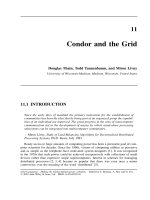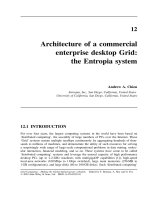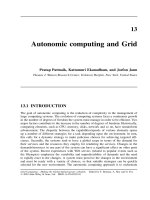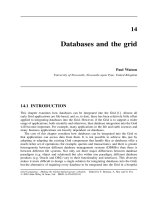Tài liệu Grid Computing P18 pdf
Bạn đang xem bản rút gọn của tài liệu. Xem và tải ngay bản đầy đủ của tài liệu tại đây (512.73 KB, 20 trang )
18
Peer-to-peer Grids
Geoffrey Fox,
1
Dennis Gannon,
1
Sung-Hoon Ko,
1
Sangmi-Lee,
1,3
Shrideep Pallickara,
1
Marlon Pierce,
1
Xiaohong Qiu,
1,2
Xi Rao,
1
Ahmet Uyar,
1,2
Minjun Wang,
1,2
and Wenjun Wu
1
1
Indiana University, Bloomington, Indiana, United States
2
Syracuse University, Syracuse, New York, United States
3
Florida State University, Tallahassee, Florida, United States
18.1 PEER-TO-PEER GRIDS
There are no crisp definitions of Grids [1, 2] and Peer-to-Peer (P2P) Networks [3] that
allow us to unambiguously discuss their differences and similarities and what it means
to integrate them. However, these two concepts conjure up stereotype images that can
be compared. Taking ‘extreme’ cases, Grids are exemplified by the infrastructure used to
allow seamless access to supercomputers and their datasets. P2P technology is exemplified
by Napster and Gnutella, which can enable ad hoc communities of low-end clients to
advertise and access the files on the communal computers. Each of these examples offers
services but they differ in their functionality and style of implementation. The P2P example
could involve services to set up and join peer groups, to browse and access files on a peer,
or possibly to advertise one’s interest in a particular file. The ‘classic’ grid could support
job submittal and status services and access to sophisticated data management systems.
Grid Computing – Making the Global Infrastructure a Reality. Edited by F. Berman, A. Hey and G. Fox
2003 John Wiley & Sons, Ltd ISBN: 0-470-85319-0
472
GEOFFREY FOX ET AL.
Grids typically have structured robust security services, while P2P networks can exhibit
more intuitive trust mechanisms reminiscent of the ‘real world’. Again, Grids typically
offer robust services that scale well in preexisting hierarchically arranged organizations;
P2P networks are often used when a best-effort service is needed in a dynamic poorly
structured community. If one needs a particular ‘hot digital recording’, it is not necessary
to locate all sources of this; a P2P network needs to search enough plausible resources
that success is statistically guaranteed. On the other hand, a 3D simulation of the universe
might need to be carefully scheduled and submitted in a guaranteed fashion to one of the
handful of available supercomputers that can support it.
In this chapter, we explore the concept of a P2P Grid with a set of services that
include the services of Grids and P2P networks and support naturally environments that
have features of both limiting cases. We can discuss two examples in which such a
model is naturally applied. In High Energy Physics data analysis (e-Science [4]) problem
discussed in Chapter 39, the initial steps are dominated by the systematic analysis of the
accelerator data to produce summary events roughly at the level of sets of particles. This
Gridlike step is followed by ‘physics analysis’, which can involve many different studies
and much debate among involved physicists as to the appropriate methods to study the
data. Here we see some Grid and some P2P features. As a second example, consider
the way one uses the Internet to access information – either news items or multimedia
entertainment. Perhaps the large sites such as Yahoo, CNN and future digital movie
distribution centers have Gridlike organization. There are well-defined central repositories
and high-performance delivery mechanisms involving caching to support access. Security
is likely to be strict for premium channels. This structured information is augmented by
the P2P mechanisms popularized by Napster with communities sharing MP3 and other
treasures in a less organized and controlled fashion. These simple examples suggest that
whether for science or for commodity communities, information systems should support
both Grid and Peer-to-Peer capabilities [5, 6].
In Section 18.2, we describe the overall architecture of a P2P Grid emphasizing the
role of Web services and in Section 18.3, we describe the event service appropriate for
linking Web services and other resources together. In the following two sections, we
describe how collaboration and universal access can be incorporated in this architecture.
The latter includes the role of portals in integrating the user interfaces of multiple services.
Chapter 22 includes a detailed description of a particular event infrastructure.
18.2 KEY TECHNOLOGY CONCEPTS FOR P2P GRIDS
The other chapters in this book describe the essential architectural features of Web ser-
vices and we first contrast their application in Grid and in P2P systems. Figure 18.1
shows a traditional Grid with a Web [Open Grid Services Architecture (OGSA)] mid-
dleware mediating between clients and backend resources. Figure 18.2 shows the same
capabilities but arranged democratically as in a P2P environment. There are some ‘real
things’ (users, computers, instruments), which we term external resources – these are the
outer band around the ‘middleware egg’. As shown in Figure 18.3, these are linked by
PEER-TO-PEER GRIDS
473
Collaboration
Broker
Composition
Computing
Security
Content access
Users and devicesClients
Middle tier of
Web services
Brokers
Service providers
Resources
Database Database
Figure 18.1 A Grid with clients accessing backend resources through middleware services.
Database
Database
Integrate P2P
and Grid/WS
Web service interfaces
Web service interfaces
Event/
message
brokers
Event/
message
brokers
P2P
P2P
Figure 18.2 A Peer-to-peer Grid.
a collection of Web services [7]. All entities (external resources) are linked by messages
whose communication forms a distributed system integrating the component parts.
Distributed object technology is implemented with objects defined in an XML-based
IDL (Interface Definition Language) called WSDL (Web Services Definition Language).
This allows ‘traditional approaches’ such as CORBA or Java to be used ‘under-the-hood’
474
GEOFFREY FOX ET AL.
Clients
Raw
resources
etc.
(Virtual) XML
rendering interface
WS WS
WS WS WS WS
Raw data Raw data
(Virtual) XML knowledge (user) interface
XML WS to WS interfaces
(Virtual) XML data interface
Web service (WS)
WS
WS
Render to XML display format
Figure 18.3 Role of Web services (WS) and XML in linkage of clients and raw resources.
with an XML wrapper providing a uniform interface. Another key concept – that of the
resource – comes from the Web consortium W3C. Everything – whether an external or
an internal entity – is a resource labeled by a Universal Resource Identifier (URI), a
typical form being escience://myplace/mything/mypropertygroup/leaf. This includes not
only macroscopic constructs like computer programs or sensors but also their detailed
properties. One can consider the URI as the barcode of the Internet – it labels everything.
There are also, of course, Universal Resource Locations (URLs) that tell you where things
are. One can equate these concepts (URI and URL) but this is in principle inadvisable,
although of course a common practice.
Finally, the environments of Figures 18.1 to 18.3 are built with a service model. A
service is an entity that accepts one or more inputs and gives one or more results. These
inputs and results are the messages that characterize the system. In WSDL, the inputs and
the outputs are termed ports and WSDL defines an overall structure for the messages.
The resultant environment is built in terms of the composition of services.
In summary, everything is a resource. The basic macroscopic entities exposed directly
to users and to other services are built as distributed objects that are constructed as
services so that capabilities and properties are accessed by a message-based protocol.
Services contain multiple properties, which are themselves individual resources. A service
corresponds roughly to a computer program or a process; the ports (interface of a commu-
nication channel with a Web service) correspond to subroutine calls with input parameters
and returned data. The critical difference from the past is that one assumes that each
PEER-TO-PEER GRIDS
475
service runs on a different computer scattered around the globe. Typically services can
be dynamically migrated between computers. Distributed object technology allows us to
properly encapsulate the services and provide a management structure. The use of XML
and standard interfaces such as WSDL give a universality that allows the interoperability
of services from different sources. This picture is consistent with that described throughout
this book with perhaps this chapter emphasizing more on the basic concept of resources
communicating with messages.
There are several important technology research and development areas on which the
above infrastructure builds:
1. Basic system capabilities packaged as Web services. These include security, access to
computers (job submittal, status etc.) and access to various forms of databases (infor-
mation services) including relational systems, Lightweight Directory Access Protocol
(LDAP) and XML databases/files. Network wide search techniques about Web services
or the content of Web services could be included here. In Section 18.1, we described
how P2P and Grid systems exhibited these services but with different trade-offs in
performance, robustness and tolerance of local dynamic characteristics.
2. The messaging subsystem between Web services and external resources addressing
functionality, performance and fault tolerance. Both P2P and Grids need messag-
ing, although if you compare JXTA [8] as a typical P2P environment with a Web
service–based Grid you will see important differences described in Section 18.3. Items
3 to 7 listed below are critical e-Science [4] capabilities that can be used more or less
independently.
3. Toolkits to enable applications to be packaged as Web services and construction of
‘libraries’ or more precisely components. Near-term targets include areas like image
processing used in virtual observatory projects or gene searching used in bioinformatics.
4. Application metadata needed to describe all stages of the scientific endeavor.
5. Higher-level and value-added system services such as network monitoring, collab-
oration and visualization. Collaboration is described in Section 18.4 and can use a
common mechanism for both P2P and Grids.
6. What has been called the Semantic Grid [9] or approaches to the representation of and
discovery of knowledge from Grid resources. This is discussed in detail in Chapter 17.
7. Portal technology defining user-facing ports on Web services that accept user control
and deliver user interfaces.
Figure 18.3 is drawn as a classic three-tier architecture: client (at the bottom), backend
resource (at the top) and multiple layers of middleware (constructed as Web services).
This is the natural virtual machine seen by a given user accessing a resource. However, the
implementation could be very different. Access to services can be mediated by ‘servers
in the core’ or alternatively by direct P2P interactions between machines ‘on the edge’.
The distributed object abstractions with separate service and message layers allow either
P2P or server-based implementations. The relative performance of each approach (which
could reflect computer/network horsepower as well as existence of firewalls) would be
used in deciding on the implementation to use. P2P approaches best support local dynamic
interactions; the server approach scales best globally but cannot easily manage the rich
476
GEOFFREY FOX ET AL.
Database
Grid middleware
Grid middleware
MP group
MP group
M
P
g
r
o
u
p
M
P
g
r
o
u
p
Database
Grid
middleware
Grid
middleware
Figure 18.4 Middleware Peer (MP) groups of services at the ‘edge’ of the Grid.
structure of transient services, which would characterize complex tasks. We refer to our
architecture as a P2P grid with peer groups managed locally arranged into a global system
supported by core servers. Figure 18.4 redraws Figure 18.2 with Grids controlling central
services, while ‘services at the edge’ are grouped into less organized ‘middleware peer
groups’. Often one associates P2P technologies with clients but in a unified model, they
provide services, which are (by definition) part of the middleware. As an example, one
can use the JXTA search technology [8] to federate middle-tier database systems; this
dynamic federation can use either P2P or more robust Grid security mechanisms. One
ends up with a model shown in Figure 18.5 for managing and organizing services. There
is a mix of structured (Gridlike) and unstructured dynamic (P2P-like) services.
We can ask if this new approach to distributed system infrastructure affects key hard-
ware, software infrastructure and their performance requirements. First we present some
general remarks. Servers tend to be highly reliable these days. Typically they run in
controlled environments but also their software can be proactively configured to ensure
reliable operation. One can expect servers to run for months on end and often one can
ensure that they are modern hardware configured for the job at hand. Clients on the other
hand can be quite erratic with unexpected crashes and network disconnections as well
as sporadic connection typical of portable devices. Transient material can be stored by
clients but permanent information repositories must be on servers – here we talk about
‘logical’ servers as we may implement a session entirely within a local peer group of
‘clients’. Robustness of servers needs to be addressed in a dynamic fashion and on a
scale greater than in the previous systems. However, traditional techniques of replication
and careful transaction processing probably can be extended to handle servers and the
PEER-TO-PEER GRIDS
477
Unstructured P2P management spaces
Structured
management spaces
Peer Group 1
Peer Group 2
P2PWS P2PWS
P2PWS
P2PWS
P2PWS
GridWS
GridWS
GridWS
GridWS
GridWS
GridWS
GridWS
GridWS
P2PWS
P2PWS
DWS/P
DWS/PP2PWSP2PWS
Figure 18.5 A hierarchy of Grid (Web) services with dynamic P2P groups at the leaves.
Web services that they host. Clients realistically must be assumed to be both unreliable
and sort of outside our control. Some clients will be ‘antiques’ and underpowered and are
likely to have many software, hardware and network instabilities. In the simplest model,
clients ‘just’ act as a vehicle to render information for the user with all the action on
‘reliable’ servers. Here applications like Microsoft Word ‘should be’ packaged as Web
services with message-based input and output. Of course, if you have a wonderful robust
PC you can run both server(s) and thin client on this system.
18.3 PEER-TO-PEER GRID EVENT SERVICE
Here we consider the communication subsystem, which provides the messaging between
the resources and the Web services. Its characteristics are of a Jekyll and Hyde nature.
Examining the growing power of optical networks, we see the increasing universal band-
width that in fact motivates the thin client and the server-based application model.
However, the real world also shows slow networks (such as dial-ups), links leading to a
high fraction of dropped packets and firewalls stopping our elegant application channels
dead in their tracks. We also see some chaos today in the telecom industry that is stunt-
ing somewhat the rapid deployment of modern ‘wired’ (optical) and wireless networks.
We suggest that the key to future e-Science infrastructure will be messaging subsystems
that manage the communication between external resources, Web services and clients
to achieve the highest possible system performance and reliability. We suggest that this
problem is sufficiently hard and that we only need to solve this problem ‘once’, that is,
478
GEOFFREY FOX ET AL.
that all communication – whether TCP/IP, User Datagram Protocol (UDP), RTP, RMI,
XML or so forth – be handled by a single messaging or event subsystem. Note that this
implies that we would tend to separate control and high-volume data transfer, reserving
specialized protocols for the latter and more flexible robust approaches for setting up the
control channels.
As shown in Figure 18.6, we see the event service as linking all parts of the system
together and this can be simplified further as in Figure 18.7 – the event service is to
provide the communication infrastructure needed to link resources together. Messaging
is addressed in different ways by three recent developments. There is Simple Object
Access Protocol (SOAP) messaging [10] discussed in many chapters, the JXTA peer-to-
peer protocols [8] and the commercial Java Message Service (JMS) message service [11].
All these approaches define messaging principles but not always at the same level of the
Open Systems Interconnect (OSI) stack; further, they have features that sometimes can
be compared but often they make implicit architecture and implementation assumptions
that hamper interoperability and functionality. SOAP ‘just’ defines the structure of the
message content in terms of an XML syntax and can be clearly used in both Grid and
P2P networks. JXTA and other P2P systems mix transport and application layers as the
message routing, advertising and discovery are intertwined. A simple example of this
is publish–subscribe systems like JMS in which general messages are not sent directly
but queued on a broker that uses somewhat ad hoc mechanisms to match publishers and
subscribers. We will see an important example of this in Section 18.4 when we discuss
collaboration; here messages are not unicast between two designated clients but rather
shared between multiple clients. In general, a given client does not know the locations of
Services
Routers/
brokers
or
S
e
r
v
e
r
s
Raw resources
C
l
i
e
n
t
s
U
s
e
r
s
Figure 18.6 One view of system components with event service represented by central mesh.
Resources
Queued events
R
e
s
o
u
r
c
e
s
R
e
s
o
u
r
c
e
s
Resources
Figure 18.7 Simplest view of system components showing routers of event service support-
ing queues.









